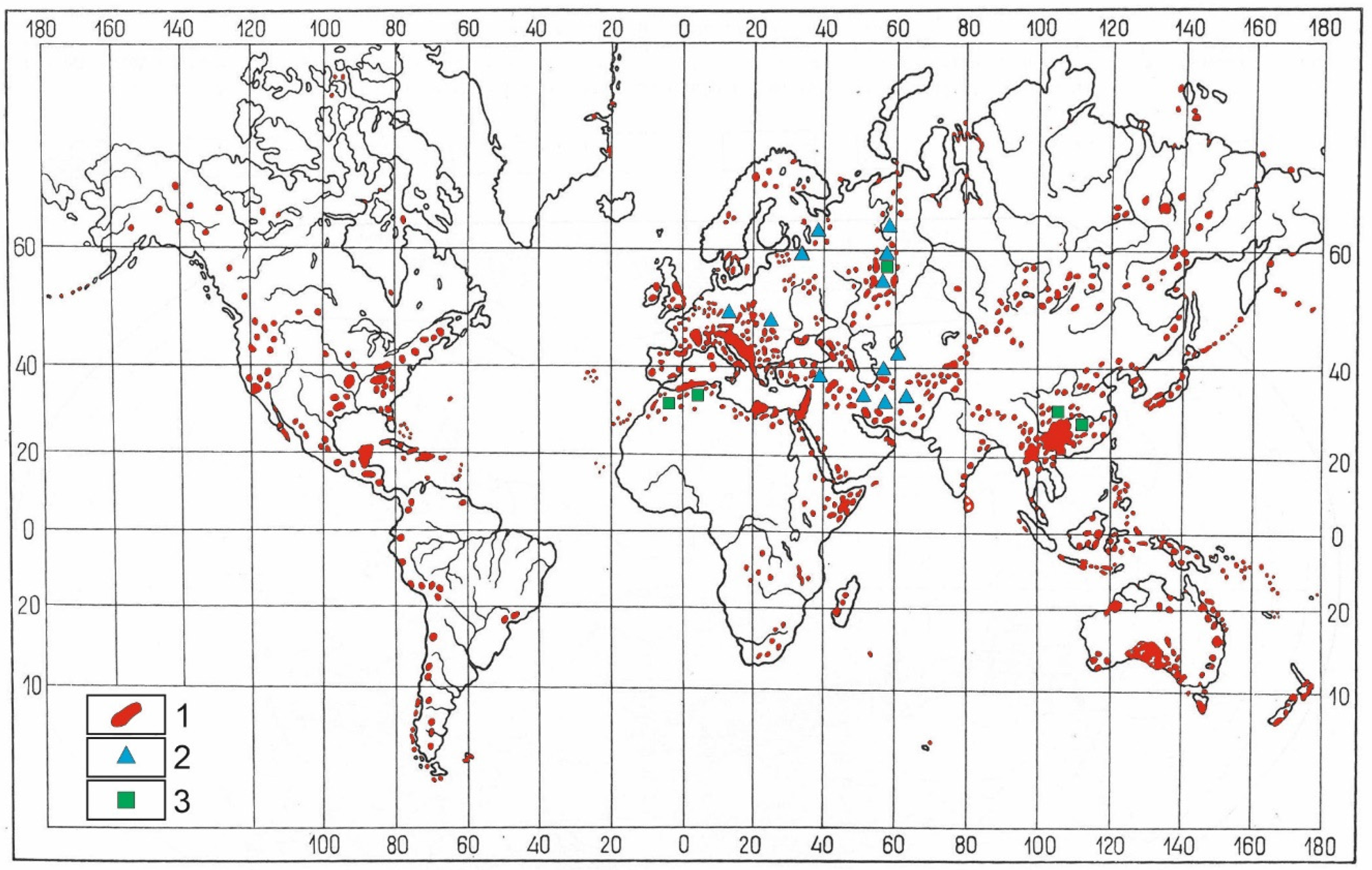This study includes a general description of the Earth’s karst types based on literary data and field observations. An improved classification of karst types distinguishes the main group, group, and subgroup; and, a division of karst types involves a main karst type, karst type, subtype, variety, and non-individual karst type. The relation between karst type and karst area is described. The role of various characteristics of karsts in the development of primary, secondary, and tertiary karst types is analyzed. Their structure is studied, which includes a geomorphic agent, process, feature, feature assemblage, karst system and the characteristics of the bearing karst area. Dominant, tributary, and accessory features are distinguished. The conditions of the stability and the development of types are studied, transformation ways are classified, and the effect of climate on types is described.
- karst type
- azonal karst type
- zonal karst type
- dynamic karst type
- structure of karst type

This entry is adapted from the peer-reviewed paper 10.3390/encyclopedia2020073
References
- Sharples, C. Geoconservation in forest management—Principles and procedures. Tasforests 1995, 7, 37–50.
- Kiernan, K. Landform classification for geoconservation. In Pattern and Process: Towards a Regional Approach to National Estate Assessment of Geodiversity; Eberhard, R., Ed.; 1997 Technical Series No. 2; Australian Heritage Commission & Environment Forest Taskforce, Environment: Canberra, Australia, 1997; pp. 21–34.
- Gray, M. Geodiversity and geoconservation: What, why, and how? In The George Wright Forum; Santucci, L.V., Ed.; George Wright Society: Hancock, MI, USA, 2005; pp. 4–12.
- Brilha, J.B. Inventory and Quantitative Assessment of Geosites and Geodiversity Sites: A Review. Geoheritage 2015, 8, 119–134.
- Kevei Bárány, I. Geodiverzitás a karsztokon (Geodiversity on karsts). Karsztfejlődés 2007, XII, 215–223. (In Hungarian)
- Balázs, D. A karsztok elterjedésének azonális és zonális feltételei (Azonal and zonal conditions of the spread of karsts). In Karszt és Barlang I; MKBT: Budapest, Hungary, 1962; pp. 19–24. (In Hungarian)
- Grund, A. Der geographische Zyklus im karst. Ges. Für Erdkd. 1914, 52, 621–640.
- Cvijič, J. Hydrographie souterraine et evolution morphologique du karst. Rev. De Geogr. Alp. 1918, 6, 375–426.
- Cvijič, J. Types morphologiques des terrains calcaires. Comptes Rendus Acad. Sci. Paris 1925.
- Gvozdetskiy, N.A. Types of Karst in the U.S.S.R. Separatum. Prob. Speleol. Res. 1965, 47–54.
- Sweeting, M.M.; Sweeting, X.E. Karst Landforms; Columbia University Press: New York, NY, USA, 1973; 362p.
- Jakucs, L. Morphogenetics of Karst Regions; Adam Hilgar: Bristol, UK, 1977; 284p.
- Komatina, M. A Fejlődés feltételei és a karsztos területek felosztása (Conditions of evolution and classification of karst areas). In Karsztterületek Hidrogeológiája; Burger, A., Dubertret, L., Eds.; MKBT: Budapest, Hungary, 1982; pp. 23–35. (In Hungarian)
- White, W.B. Geomorphology and Hydrology of Karst Terrains; Oxford University Press: New York, NY, USA, 1988; 464p.
- Balázs, D. Kína karsztvidékei (Karst regions of China). In Karszt És Barlang II; Magyar Karszt-és Barlangkutató Társulat: Budapest, Hungary, 1986; pp. 123–132. (In Hungarian)
- Balázs, D. A dél-kínai karsztvidék főbb barlangtípusai (Main cave types of the South-China karst region). In Karszt És Barlang I; Magyar Karszt-és Barlangkutató Társulat: Budapest, Hungary, 1990; pp. 53–60. (In Hungarian)
- Veress, M. Karst Types and Their Karstification. J. Earth Sci. 2020, 31, 621–634.
- Veress, M.; Vetési-Foith, S. Geodiversity of surface karst features of geographical zones. Acta Carsologica 2021, 50, 2–3.
- Ford, D.C.; Williams, P.W. Karst Hydrogeology and Geomorphology; John Wiley & Sons: Hoboken, NJ, USA, 2007; 561p.
- Cseh-Németh, J. Az Úrkúti mangánérc telep kifejlődési típusai (Development types of the manganese ore colony of Úrkút). Földtani Közlöny (Bull. Hung. Geol. Soc.) 1958, 88, 399–415. (In Hungarian)
- Bíró, B. A halimbai és nyirádi bauxitelőfordulások karsztos fekvője (Karstic bedrock of the bauxite occurrences of Halimba and Nyirád). Földtani Közlöny (Bull. Hung. Geol. Soc.) 1969, 99, 98–104. (In Hungarian)
- Veress, M. Subterranean Physiography. J. Earth Environ. Sci. 2022, 2, 1–14.
